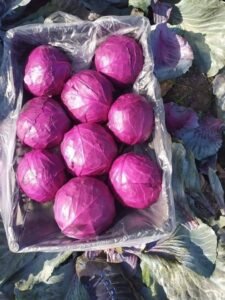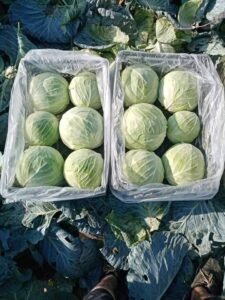Vegetables ready for export

We know we need to eat a minimum of 5 servings of fruit and vegetables everyday. Actually now, to prevent cancer, 8 to 13 servings per day are recommended. A serving is one cup of raw fruits or vegetables, or ½ cup ,,,,,d. At a recent lecture I asked a lunch audience to raise their hand if they had at least one fruit or vegetable already that day. No one in that group raised their hand. This is not uncommon. Our processed and convenience foods contain very few fruits and vegetables.
Each color found in fruits and vegetables focus on building the immune system in its own way. It is important to get a variety of colors, so that you will get a full range of phytochemicals (beneficial plant chemicals) in your daily diet. Research is finding that eating whole fruits and vegetables gives you many more nutrients than you could possible add to a vitamin and mineral supplement. There are over 12,000 phytochemicals, and I have yet to see a supplement, unless it has whole fruits and vegetables in it, have all of the 180 different vitamins or minerals that are required by our **** to function daily.
The different colors in fruits and vegetables help our immune system react to different stresses in our daily life. So look at the different colors in your diet. See if they include each of the colors listed below. This is one way to know that you are getting the full benefit of nutrients possible in your diet.
Green Foods – broccoli, kale, leaf and romaine lettuce, , cabbage and Brussels sprouts.
Green foods are especially good for the circulatory system. They contain many minerals and B-complex vitamins. Some phytochemicals found in green foods are sulforaphane and indoles that are very powerful anti-cancer compounds. Researchers have tried to use these as isolated phytochemicals but find that they only work while in the whole food form.
Red Foods – tomatoes, watermelon, red cabbage.
Red foods contain many phytochemicals that reduce free radical damage. The phytochemical called lycopene is especially helpful to prevent prostate problems, and reduce the effects of sun damage on the skin. Lycopene is the phytochemical that make the red foods get their red color.
Orange Foods – carrots, pumpkin, squash, sweet potatoes, apricots, cantaloupe.
The orange foods have the carotenoids the help prevent cancer by repairing the DNA. As our mothers told us, carrots, and other orange foods, are especially good for our eyes, and help with night vision. The deep orange foods help our bodies get the vitamin A we need, without getting excess that can lead to osteoporosis.
Green/Yellow Foods – yellow corn, green peas, collard greens, avocado and honeydew melon.
This combination of green and yellow foods contains the carotenoids lutein and zeaxanthin that help reduce the risk of developing cataracts and macular degeneration. These foods are also helpful in reducing the risk of osteoporosis.
Orange /Yellow Foods – oranges, pineapple, tangerines, peaches, papaya, nectarines
These foods that are orange and yellow in color are high in antioxidants, especially Vitamin C, and help to improve the health of the mucus membranes and connective tissue. They help prevent heart disease by improving circulation and preventing inflammation.
White/Green Foods – onions, garlic, celery, pears, chives
When you make a salad make sure you have a variety of different colors. Strive to get at least 5 colors on your plate. Use fruits to balance the rest of the colors needed. This way you will get closer to the 8
to 13 servings of fruits and vegetables required, and you will get the variety of nutrients you need daily.
Our products are ready for export, fresh and frozen, to all over the world
pepper
White and red cabbage







